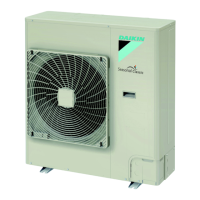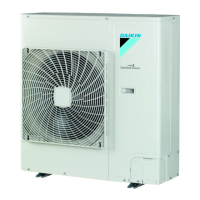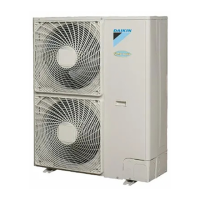
Do you have a question about the Daikin RZQSG125L8V1B and is the answer not in the manual?
| Brand | Daikin |
|---|---|
| Model | RZQSG125L8V1B |
| Category | Air Conditioner |
| Language | English |
Explains the severity and probability of occurrence for warning symbols.
Defines terms like Installation manual, Operation manual, Dealer, Installer, User.
Highlights important safety topics to follow during installation.
Provides general safety precautions before starting installation.
Details strict cautions for keeping the R410A refrigerant system clean, dry, and tight.
Warns about disconnecting power before touching electrical parts and safety measures.
Warns about touching hot or cold piping and internal parts during or after operation.
General warnings about improper installation and environmental considerations.
Lists places to avoid for installation due to potential hazards like oil, gas, or electromagnetic waves.
Details precautions for R410A refrigerant, including system cleanliness and tightness.
Instructions for installing the outdoor unit and referencing indoor unit manuals.
Explains model differences for low ambient temperature operation and humidity conditions.
Lists accessories included with the unit and references a figure for location.
Instructions on how to safely handle the unit during installation.
Guidelines for selecting an appropriate installation site considering ventilation, noise, and safety.
Specific instructions for installing in low outdoor ambient temperatures to prevent wind exposure.
Guidance on ensuring a strong and level installation ground for the unit.
Describes how to secure the unit to prevent it from falling over.
Instructions for proper drain pipe installation and snow escape measures.
Details required service spaces for installation based on operating conditions.
Specifies required clearances for single and multiple unit installations.
Guidelines for installing units in a stacked configuration, including roof cover and spacing.
Instructions for installing units in multiple rows, typically for roof top use.
Specifies the required construction material and temper grade for refrigerant copper piping.
Provides tables for selecting the correct refrigerant pipe sizes for various models and configurations.
Details the selection of branch pipes for twin, triple, and double twin systems.
Lists maximum allowable piping lengths and height differences for different system configurations.
General precautions for handling refrigerant piping, including avoiding foreign objects and using correct tools.
Instructions on making flares for refrigerant piping, including dimensions and tightening torques.
Procedures and precautions for brazing refrigerant piping, emphasizing nitrogen purging.
Instructions on how to safely operate the stop valves, including opening and closing procedures.
Table specifying the correct tightening torques for stem caps and service port caps.
Methods to prevent dirt, dust, and small animals from entering the piping system.
Advice on connecting field piping, insulation, and preventing condensation.
Explains when and where to install traps in the riser gas piping to ensure oil return.
General procedures for leak testing and vacuum drying the refrigerant system.
Lists the necessary equipment for performing leak tests and vacuum drying.
Details the procedures for performing vacuum leak tests and pressure leak tests.
Step-by-step instructions for removing moisture from the refrigerant piping.
Provides information on the refrigerant type (R410A) and its GWP value.
General precautions and guidelines for charging refrigerant into the system.
Instructions and tables for calculating the correct amount of additional refrigerant to charge.
Instructions for complete recharging of the system, especially after leaks.
Provides tables for the total charging weight of refrigerant based on piping length.
General safety precautions to be taken during electrical wiring.
Instructions for connecting the power supply and wiring between indoor and outdoor units.
Specific precautions for wiring power supply and inter-unit connections, including terminal tightening.
Lists specifications for standard wiring components like wire types and fuses.
A checklist of items to verify before performing a test run of the unit.
Instructions for confirming remote controller settings for different series.
Step-by-step guide on how to perform the initial test run of the installed unit.
Important precautions to observe during test runs, including initial operation and controller behavior.
Guidance on diagnosing common malfunctions and error codes during initial installation.











